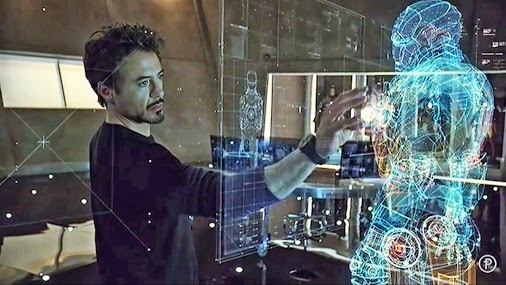Gesture recognition is no longer unique to the sci-fi movie genre. Whether it was Tom Cruise manipulating glimpses into the future on a giant transparent screen or Robert Downey Jr taking apart his virtual Iron Man suit in his basement lab, most of us used to think that it was all restricted to the fantasy world. However recent advances in gestural interfaces have led us to realise that we too might soon be able to harness this amazing technology for ourselves.
Simply taking a brief look at the video below demonstrates just one of many upcoming products taking this technology to market. This is the Leap Motion which essentially supports hand motions as an input, as a replacement to a traditional mouse[1]. Leap Motion Inc. is in partnership with ASUS and together they are one of the many groups looking to bring us this new technology.
Gestural Interfaces encourage HMI (Human-Machine Interaction) and could potentially make current input devices (such as computer mice, keyboards and even touchscreens) redundant in the future.
Unfortunately it's not as simple as a camera seeing you move your hand and knowing that you want to turn a page in an e-book or turn up the volume of your TV programme. This technology uses mathematical algorithms[2] to interpret human gestures and then transform them into visual functions on a display. Essentially the sensor detects changes in the physical environment and transforms them into computer inputs for digital processing inside the machine. From there it can display the resultant action.
There is of course the obvious disadvantage of lack of compatibility with disabled people (for example people with loss of limbs/digits), however improvements are being made to combat this such as with accelerometer based gesture controlled systems[3].
So how does this relate to publishing? Well such a prominent future technology requires attention from all branches of a company, none more so than the people who are actually going to publish the applications or products. When it comes to the hype cycle of emerging technologies, gesture recognition is past the trough of disillusionment and well on its way through the slope of enlightenment to the plateau of productivity[4].
In conclusion then, gestural interfaces signal the next trend in computer and display technology, and after further development could be seen to be standard in the average home.
Word count: 388
Unfortunately it's not as simple as a camera seeing you move your hand and knowing that you want to turn a page in an e-book or turn up the volume of your TV programme. This technology uses mathematical algorithms[2] to interpret human gestures and then transform them into visual functions on a display. Essentially the sensor detects changes in the physical environment and transforms them into computer inputs for digital processing inside the machine. From there it can display the resultant action.
There is of course the obvious disadvantage of lack of compatibility with disabled people (for example people with loss of limbs/digits), however improvements are being made to combat this such as with accelerometer based gesture controlled systems[3].
So how does this relate to publishing? Well such a prominent future technology requires attention from all branches of a company, none more so than the people who are actually going to publish the applications or products. When it comes to the hype cycle of emerging technologies, gesture recognition is past the trough of disillusionment and well on its way through the slope of enlightenment to the plateau of productivity[4].
In conclusion then, gestural interfaces signal the next trend in computer and display technology, and after further development could be seen to be standard in the average home.
Word count: 388
References
Minority Report image: http://www.artefactgroup.com/content/wp-content/uploads/2011/02/Tom-Cruise-minority-Report.jpg
Iron Man image: https://lh4.googleusercontent.com/-5WWpeHSjIPw/UajTluk7-4I/AAAAAAAApUg/dTETe_uyCYs/w506-h285-o/iron-man-gestures.jpg
[1] https://www.leapmotion.com/company - Accessed 12/10/2013
[2] http://mm-werkstatt.informatik.uni-augsburg.de/files/publications/199/wave_like_an_egyptian_final.pdf - Accessed 12/10/2013
[3] Moniruzzaman Bhuiyan (Sept 2011) - www.scirp.org/journal/PaperDownload.aspx?paperID=7503 (PDF) - Accessed 13/10/2013
[4] Gartner (July 2012) - Accessed 13/10/2013
Minority Report image: http://www.artefactgroup.com/content/wp-content/uploads/2011/02/Tom-Cruise-minority-Report.jpg
Iron Man image: https://lh4.googleusercontent.com/-5WWpeHSjIPw/UajTluk7-4I/AAAAAAAApUg/dTETe_uyCYs/w506-h285-o/iron-man-gestures.jpg
[1] https://www.leapmotion.com/company - Accessed 12/10/2013
[2] http://mm-werkstatt.informatik.uni-augsburg.de/files/publications/199/wave_like_an_egyptian_final.pdf - Accessed 12/10/2013
[3] Moniruzzaman Bhuiyan (Sept 2011) - www.scirp.org/journal/PaperDownload.aspx?paperID=7503 (PDF) - Accessed 13/10/2013
[4] Gartner (July 2012) - Accessed 13/10/2013


 RSS Feed
RSS Feed